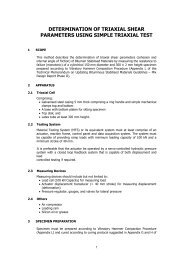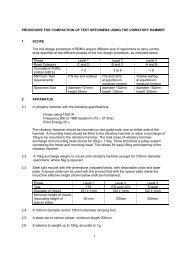Updating Bituminous Stabilized Materials Guidelines Mix Design Report Phase II
Moisture Sensitivity: Part II (Validation) - Asphalt Academy
Moisture Sensitivity: Part II (Validation) - Asphalt Academy
- No tags were found...
Create successful ePaper yourself
Turn your PDF publications into a flip-book with our unique Google optimized e-Paper software.
Figure J.22 illustrates the comparison of the strength reduction of BSMs from dry trafficking to<br />
wet trafficking conditions. The wet trafficking ITS shows a decrease in strength from dry<br />
trafficking ITS. However the comparison of the ITS values shows no significant difference for<br />
most of the BSMs tested, with some exceptions i.e. BSM-emulsion with Quartzites. This indicates<br />
that ITS test is not particularly sensitive to moisture effects.<br />
From previous analysis, see Section 4.1, the resistance to disintegration and ravelling by a long<br />
cured BSM-emulsion, indicated high moisture resistance. However, looking at the ITS values, the<br />
difference between highly moisture resistant to highly moisture susceptible BSMs is insignificant.<br />
This confirm the weakness of the ITS test, as reported previously by Hodgkinson, (2004). The<br />
lack of reliability and repeatability of the ITS test for use in ranking BSMs in terms of moisture<br />
susceptibility, should preclude its use for important applications of BSMs.<br />
ITS [kPa]<br />
400<br />
350<br />
300<br />
250<br />
200<br />
150<br />
100<br />
50<br />
0<br />
H+1C-E01 (long cured<br />
G2+0C-E02<br />
G2+1C-E01<br />
G2+0C-F01<br />
H+0C-E01<br />
BSM-<strong>Mix</strong>es<br />
Q+0C-E04<br />
H+1C-E02<br />
H+1L-E02<br />
Wet Trafficked ITS<br />
Dry Trafficked ITS<br />
Figure J.22: Comparison of ITS results after wet and dry MMLS3<br />
trafficking on different BSMs<br />
Further, comparison of the ITS values shows an increase in the moisture-sensitivity of the BSMs<br />
from initial study to additional study. However, it should be noted that in the initial study, wet<br />
trafficking terminated at 250 and 900 load applications after ravelling depth of 2mm to 4mm,<br />
while in the additional study, wet trafficking terminated at a 2500 and 45000 load application<br />
after ravelling-depth of 4mm to 12-14mm.<br />
Ravelling-depth of 4mm under the MMLS3 appears to be critical, see Figure J.20 and Figure<br />
J.21. At 4mm of ravelling BSMs experiences severe cohesion loss of stiffness reduction.<br />
Thereafter exponential disintegration occurs. It is appropriate to extend testing beyond 4mm of<br />
ravelling during moisture susceptibility testing with the MMLS3 trafficking.<br />
28












